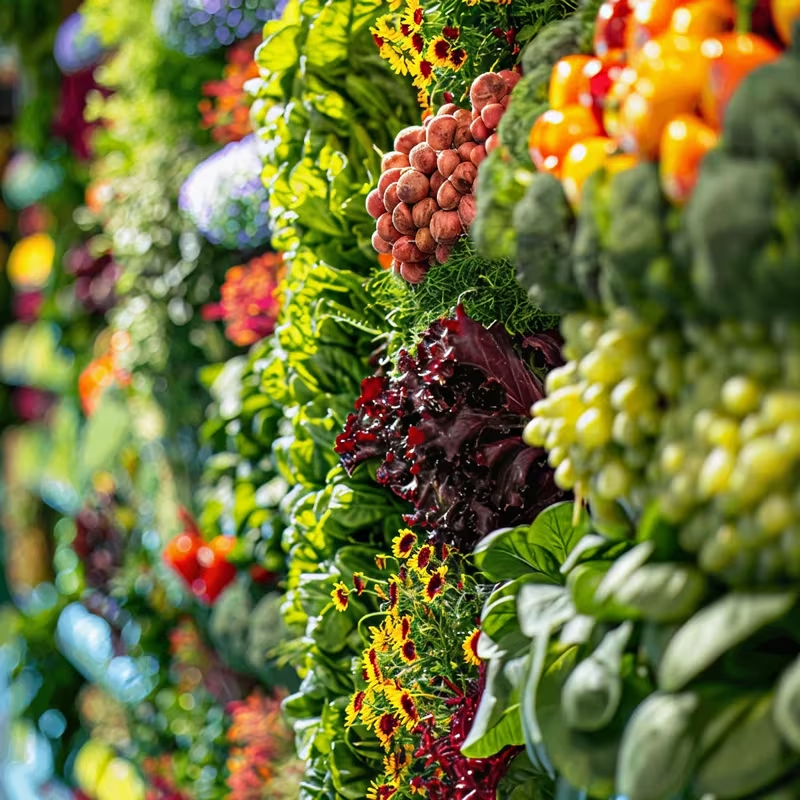
Vertical Farming Crops
Vertical crops refer to the cultivation of plants in stacked layers or vertically inclined surfaces, often using hydroponic, aeroponic, or other soil-free systems. This innovative farming method maximizes space, increases crop yield, and reduces resource consumption such as water and energy. Ideal for urban settings with limited space, vertical farming supports the sustainable production of crops like leafy greens, herbs, and certain fruits and vegetables, offering a solution to food security challenges while minimizing environmental impact.
What is Vertical Farming?
Vertical farming is an innovative method of crop cultivation that involves growing plants in vertically stacked layers, optimizing the use of available space. This approach isn't entirely new, as it builds on techniques like hydroponics, aquaponics, and aeroponics, which enable soil-free plant growth using nutrient solutions or mist. These systems are typically housed in controlled indoor environments where factors such as light, temperature, humidity, and CO2 levels can be precisely regulated to create optimal conditions for plant growth.
The primary goal of vertical farming is to enable food production in urban areas where traditional farming is not feasible due to limited space. This method not only optimizes the use of resources such as water, energy, and land but also helps reduce the environmental footprint. Vertical crops, such as leafy greens, herbs, fruits,vegetables and edible flowers, can be successfully grown even in densely populated regions, providing sustainable solutions to food security challenges in urban environments.
Types of Crops Grown in Vertical Farming
Vertical farming can be used to cultivate a variety of crops, from leafy greens and herbs to fruits and even certain root vegetables. However, due to space limitations and system requirements, some crops are more suitable for vertical farming than others.
Leafy Greens
Leafy greens, such as lettuce, spinach, kale, arugula, and Swiss chard, are among the most commonly grown crops in vertical farms. These plants thrive in controlled conditions, allowing for year-round production independent of seasonal changes. With their relatively low maintenance and small space requirements, leafy greens are particularly well-suited for vertical farming. Additionally, these crops grow quickly, often maturing in just a few weeks, which provides farmers with a rapid turnover and maximizes space and resource use. This fast growth cycle allows for frequent harvesting, providing fresh, nutritious crops in urban environments.
Herbs
Herbs like basil, mint, cilantro, parsley, and oregano are also highly popular in vertical farming. These plants require minimal space and adapt well to hydroponic and aeroponic systems. Herbs grow quickly and are in high demand in culinary applications, making them a highly profitable crop for urban farmers. The controlled conditions in vertical farms allow for year-round harvesting, ensuring consistent quality and supply. This approach not only optimizes space but also meets the constant demand for fresh, aromatic herbs in city environments, providing consumers with premium products at all times.
Microgreens
Microgreens are young, edible plants harvested at an early stage of growth, including varieties such as radishes, mustard, Swiss chard, and sunflower and pea shoots. These plants are exceptionally nutritious and have gained popularity in the culinary world due to their vibrant colors, intense flavors, and numerous health benefits. Microgreens grow extremely quickly, often ready for harvest within 7 to 21 days, making them ideal candidates for vertical farming. Since they require minimal space, they fit well into the stacked layers of vertical farms, allowing for efficient production in limited spaces. Moreover, the quick maturation of microgreens enables farmers to achieve high productivity and meet the growing demand for these fresh, nutrient-packed delicacies.
Strawberries
Strawberries are one of the few fruits successfully cultivated in vertical farming, despite the fact that many other fruit crops are not suitable due to their size and growth conditions. Vertical farming systems allow strawberries to be grown in compact, controlled environments, often using vertical towers that optimize space. Advanced techniques such as aeroponics and hydroponics enable strawberry cultivation without soil, making the process more efficient and environmentally friendly. These systems allow for precise control of factors such as light levels, humidity, and nutrients. The controlled environment of vertical farms also reduces the risk of pests and diseases, minimizing the need for pesticides and resulting in healthier, more environmentally-friendly strawberries.
Tomatoes
Tomatoes are another crop that has shown great potential in vertical farming systems, especially varieties like cherry tomatoes and grape tomatoes. While larger tomato plants typically require more space and support, smaller varieties thrive in vertical farm conditions. Tomatoes grown in vertical farms often have superior taste and quality because they are cultivated in controlled, pesticide-free environments, which allow for better fruit quality. Vertical farming not only provides optimal growing conditions but also extends the growing season, enabling year-round tomato production.
Peppers
Peppers, including bell peppers and chili peppers, adapt well to vertical farming due to their compactness and ability to thrive in controlled environments. Like tomatoes, peppers are often grown in hydroponic or aeroponic systems, allowing them to grow in nutrient solutions without soil. These innovative systems not only optimize space but also significantly reduce the risk of pests and diseases, making peppers a clean, healthy, and efficient crop for urban farms.
Cucumbers
Cucumbers are another crop that can be successfully grown in vertical farming systems. Vertical farming uses hydroponic systems, where cucumbers can grow in nutrient solutions without soil. These systems support vertical growth, allowing cucumbers to climb on trellises or other structures, maximizing space and improving production efficiency. The controlled environment also helps regulate temperature and humidity, which is crucial for optimal cucumber growth.
Edible Flowers
Edible flowers, such as nasturtium, violets, and marigolds, are becoming increasingly popular in vertical farming. These plants are not only used in culinary applications but also for decorative and medicinal purposes. Vertical farming offers ideal conditions for growing these plants, as it allows for year-round production in controlled, pesticide-free environments. Edible flowers can be grown in small spaces, making them a perfect choice for vertical farms looking to diversify their crops.
Benefits of Vertical Farming for Crop Production
Vertical farming offers a range of environmental and economic benefits. One of the key advantages is efficient resource use, as hydroponic and aeroponic systems use up to 90% less water compared to traditional farming methods. This approach is particularly valuable in regions with limited water resources. Furthermore, vertical farming enables higher yields per square meter, as crops are grown in stacked layers, maximizing the use of available space. This is crucial in urban areas where space is often limited. Food production in cities reduces the need for long-distance transportation, which in turn reduces the carbon footprint and harmful gas emissions. The controlled conditions in vertical farms also minimize the need for pesticides and herbicides, contributing to the preservation of the natural environment. In this way, vertical farming is not only sustainable but also an environmentally-friendly option for the future.
Revolutionizing Farming with Vertical Crops
Vertical farming presents innovative and sustainable solutions to many of the challenges faced by traditional agriculture, such as limited space, high water usage, and environmental impact. By focusing on specific crops, vertical farming enables efficient and productive food production in urban areas. With the use of advanced technologies, vertical farms can significantly reduce resource requirements while achieving higher yields per square meter. As technology continues to advance and the demand for locally produced, sustainable food grows, vertical farming will become an increasingly important player in feeding the world’s growing population.






